Shipbuilding in 2026

Andrew Craig-Bennett is back. In his first column since May, he mulls shipowners, shipyards and the realities of decarbonisation.
I must apologise for having been unwell. I am now better. I will pick up where I left off.
I expect that you read Pierre Aury’s article on May 3, titled Of camels and horses. It introduced me to CBAM, the Carbon Border Adjustment Mechanism, which is the measure that the European Union has put in place to try to stop more carbon-intensive manufacturing processes moving out of the EU and carrying on as before. It’s a good article to read if you want to bring yourself up to date with emissions control legislation.
I expect you have also read Sam Chambers’ article on May 2, one day earlier, titled Owners face severe yard bottleneck, in which Sam, having talked to brokers, to bankers and to other experts, finds that there are effectively no building slots available for 2024 (no surprise) or 2025 and only a very few for 2026.
I want to talk about the way in which two articles in the same publication appear to exist in parallel universes, but first a little more about shipbuilding.
Welcome to the quantum theory of shipyard capacity. Most people know that there is no such a thing as a shipyard building slot. Shipyard building slots are virtual. You can’t kick one. A building slot represents a given number of man hours, a given quantity of materials and an amount of building dock time. The only one of these that is both real and critical, and only then during the top of a shipbuilding boom, is the main engine. If you can’t get a main engine, you can’t have a ship. Everything else can be flexed, adjusted, and generally worked around. Even skilled labour can be adjusted; it can be begged, borrowed, lured out of retirement, or just spread more thinly with more apprentices per skilled worker.
Modern shipbuilding is very much a matter of the costings department and above all the purchasing department. In this it much resembles shipmanagement, which is also largely a matter of purchasing department wizardry. Other people may think that their work is also important, but they are mistaken. Shipbuilding is almost all about purchasing.
Brokers like to talk about the lowest price slot for a given order. They say that their task on behalf of the buyer is to find that cheapest slot and negotiate it. You will see at once that this lowest cost slot is conjured into existence by the broker and when the letter of intent is signed it becomes real, with all the yard’s purchase orders, the stage payments and so on hanging off it, and a new lowest cost slot pops into existence.
We see, from Sam’s article, that yard prices are generally high and that we are in what we might venture to call a boom. On the other hand, Maersk has just told us that we are in no such thing and that freight rates are about to go through the floor. You see that the concept of parallel universes can be handy.
Let’s add two more worlds; the universe of decarbonisation, in which the shipowner navigates oceans of regulation, something that we are all well used to, and another universe that we know well, the universe of unintended consequences, in which the merry men read the new regulations in a spirit of enterprise.
The central problem here is that nobody knows what the ship of the future will look like, and they have even less of an idea about what the freight market of the future will look like. Nor does anyone much care. For the moment, people are guessing, and the most popular guess is that the freight market will look much the same and the ships will be dual fuel ships; low sulphur fuel oil and something else – methane, methanol, ammonia, hydrogen. To this we can add some decorative touches like Flettner rotors, rigid wing sails, and such like, and claim that our ship is sail-assisted.
In this quantum world, one thing that we can be sure of is that the calculations and assumptions on which a ship was ordered will be wildly wrong by the time the block sections are going into the building dock. The horizon is not 20, but two years away. That is why nobody in shipping is really committed to decarbonisation. Oh, people talk about it, and with any luck a good few will be offended by the honesty, which they will call cynicism of these words. People in public-facing shipping companies are committed to greenwashing, but nobody is serious about the elimination of carbon dioxide in emissions from ships.
Nobody is serious. Nobody. Because we make our money by getting paid to move stuff from A to B, and the clever ones amongst us make lots of money by reading regulations in a spirit of enterprise.
We do not get paid to save the planet. This is going to be a problem, but we all think it will be our great-grandchildren’s problem. This idea has some interesting consequences for us in the real world of the present day and the two- to five-year time horizon of the world of merchant shipping.
Enjoyed this column? Check out all of Andrew’s articles for Splash by clicking here.

Ramen to that!
“What oft was thought, but n’er so well express’d”, David!